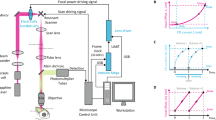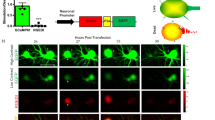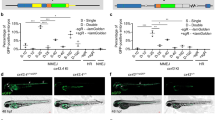Abstract
The tracking of cell fate, shape and migration is an essential component in the study of the development of multicellular organisms. Here we report a protocol that uses the protein Kaede, which is fluorescent green after synthesis but can be photoconverted red by violet or UV light. We have used Kaede along with confocal laser scanning microscopy to track labeled cells in a pattern of interest in zebrafish embryos. This technique allows the visualization of cell movements and the tracing of neuronal shapes. We provide illustrative examples of expression by mRNA injection, mosaic expression by DNA injection, and the creation of permanent transgenic fish with the UAS-Gal4 system to visualize morphogenetic processes such as neurulation, placode formation and navigation of early commissural axons in the hindbrain. The procedure can be adapted to other photoconvertible and reversible fluorescent molecules, including KikGR and Dronpa; these molecules can be used in combination with two-photon confocal microscopy to specifically highlight cells buried in tissues. The total time needed to carry out the protocol involving transient expression of Kaede by injection of mRNA or DNA, photoconversion and imaging is 2–8 d.
This is a preview of subscription content, access via your institution
Access options
Subscribe to this journal
Receive 12 print issues and online access
$259.00 per year
only $21.58 per issue
Buy this article
- Purchase on Springer Link
- Instant access to full article PDF
Prices may be subject to local taxes which are calculated during checkout






Similar content being viewed by others
References
Ando, R., Hama, H., Yamamoto-Hino, M., Mizuno, H. & Miyawaki, A. An optical marker based on the UV-induced green-to-red photoconversion of a fluorescent protein. Proc. Natl. Acad. Sci. USA 99, 12651–12656 (2002).
Ando, R., Mizuno, H. & Miyawaki, A. Regulated fast nucleocytoplasmic shuttling observed by reversible protein highlighting. Science 306, 1370–1373 (2004).
Tsutsui, H., Karasawa, S., Shimizu, H., Nukina, N. & Miyawaki, A. Semi-rational engineering of a coral fluorescent protein into an efficient highlighter. EMBO Rep. 6, 233–238 (2005).
Aramaki, S. & Hatta, K. Visualizing neurons one-by-one in vivo: Optical dissection and reconstruction of neural networks with reversible fluorescent proteins. Dev. Dyn. 235, 2192–2199 (2006).
Ciruna, B., Jenny, A., Lee, D., Mlodzik, M. & Schier, A.F. Planar cell polarity signalling couples cell division and morphogenesis during neurulation. Nature 439, 220–224 (2006).
Turner, D.L. & Weintraub, H. Expression of achaete-scute homolog 3 in Xenopus embryos converts ectodermal cells to a neural fate. Genes Dev. 8, 1434–1447 (1994).
Sato, T., Takahoko, M. & Okamoto, H. HuC:Kaede, a useful tool to label neural morphologies in networks in vivo. Genesis 44, 136–142 (2006).
Fischer, J.A., Giniger, E., Maniatis, T. & Ptashne, M. GAL4 activates transcription in Drosophila. Nature 332, 853–856 (1988).
Scheer, N. & Campos-Ortega, J.A. Use of the Gal4-UAS technique for targeted gene expression in the zebrafish. Mech. Dev. 80, 153–158 (1999).
Köster, R.W. & Fraser, S.E. Tracing transgene expression in living zebrafish embryos. Dev. Biol. 233, 329–346 (2001).
Scheer, N., Groth, A., Hans, S. & Campos-Ortega, J.A. An instructive function for Notch in promoting gliogenesis in the zebrafish retina. Development 128, 1099–1107 (2001).
Halloran, M.C. et al. Laser-induced gene expression in specific cells of transgenic zebrafish. Development 127, 1953–1960 (2000).
Girdham, C.H. & O'Farrell, P.H. The use of photoactivatable reagents for the study of cell lineage in Drosophila embryogenesis. Methods Cell Biol. 44, 533–543 (1994).
Scheer, N., Riedl, I., Warren, J.T., Kuwada, J.Y. & Campos-Ortega, J.A. A quantitative analysis of the kinetics of Gal4 activator and effector gene expression in the zebrafish. Mech. Dev. 112, 9–14 (2002).
Cooper, M.S., D'Amico, L.A. & Henry, C.A. Confocal microscopic analysis of morphogenetic movements. Methods Cell Biol. 59, 179–204 (1999).
Westerfield, M. The Zebrafish Book: a Guide for the Laboratory Use of Zebrafish (Danio rerio) 4th edn. (Univ. of Oregon Press, Eugene, Oregon, 2000).
Kimmel, C.B., Ballard, W.W., Kimmel, S.R., Ullmann, B. & Schilling, T.F. Stages of embryonic development of the zebrafish. Dev. Dyn. 203, 253–310 (1995).
Streisinger, G., Coale, F., Taggart, C., Walker, C. & Grunwald, D.J. Clonal origins of cells in the pigmented retina of the zebrafish eye. Dev. Biol. 131, 60–69 (1989).
Nüsslein-Volhard, C. & Dahm, R. Zebrafish. Practical Approach Series No. 261 (Oxford University Press, Oxford, 2002).
Park, H.C. et al. Analysis of upstream elements in the HuC promoter leads to the establishment of transgenic zebrafish with fluorescent neurons. Dev. Biol. 227, 279–293 (2000).
Higashijima, S., Masino, M.A., Mandel, G. & Fetcho, J.R. Imaging neuronal activity during zebrafish behavior with a genetically encoded calcium indicator. J. Neurophysiol. 90, 3986–3997 (2003).
Kawakami, K., Shima, A. & Kawakami, N. Identification of a functional transposase of the Tol2 element, an Ac-like element from the Japanese medaka fish, and its transposition in the zebrafish germ lineage. Proc. Natl. Acad. Sci. USA 97, 11403–11408 (2000).
Kawakami, K. et al. A transposon-mediated gene trap approach identifies developmentally regulated genes in zebrafish. Dev. Cell 7, 133–144 (2004).
Gilbert, S. Developmental Biology 8th edn. (Sinauer Associates, Sunderland, Massachusetts, 2006).
Acknowledgements
We thank S. Aizawa for support; S. Hayashi for encouragement; S. Aramaki, H. Togashi, S. Yonemura, M. Hibi and K. Agata for help; M. Royle for comments and J. Clarke for encouraging us to publish this protocol. pKaede1 and pKikGR3 were kindly provided by A. Miyawaki; pEF:Gal4VP16, pUlyn and pEF:Gal4VP16-UlynU2B17 by R. Köster and S. Fraser; pDeltaD:Gal4 (ref. 11) by N. Sheer and J. Campos-Ortega; the HuC promoter20,21 by S. Higashijima; the HSP promoter12 by W. Shoji; vectors for T2 transposon–mediated gene transfer22,23 by K. Kawakami and Tg(deltaD:Gal4)11 and Tg(hsp:Gal4)14 by the Zebrafish International Resource Center. K.H. received grants-in-aid for Scientific Research from The Ministry of Education, Culture, Sports, Science, and Technology of Japan.
Author information
Authors and Affiliations
Corresponding author
Ethics declarations
Competing interests
The authors declare no competing financial interests.
Rights and permissions
About this article
Cite this article
Hatta, K., Tsujii, H. & Omura, T. Cell tracking using a photoconvertible fluorescent protein. Nat Protoc 1, 960–967 (2006). https://doi.org/10.1038/nprot.2006.96
Published:
Issue Date:
DOI: https://doi.org/10.1038/nprot.2006.96
This article is cited by
-
A brain-specific angiogenic mechanism enabled by tip cell specialization
Nature (2024)
-
Haematopoietic stem and progenitor cell heterogeneity is inherited from the embryonic endothelium
Nature Cell Biology (2023)
-
Biomechanics and neural circuits for vestibular-induced fine postural control in larval zebrafish
Nature Communications (2023)
-
Ca2+-imaging and photo-manipulation of the simple gut of zebrafish larvae in vivo
Scientific Reports (2022)
-
To be or not to be: endothelial cell plasticity in development, repair, and disease
Angiogenesis (2021)
Comments
By submitting a comment you agree to abide by our Terms and Community Guidelines. If you find something abusive or that does not comply with our terms or guidelines please flag it as inappropriate.



